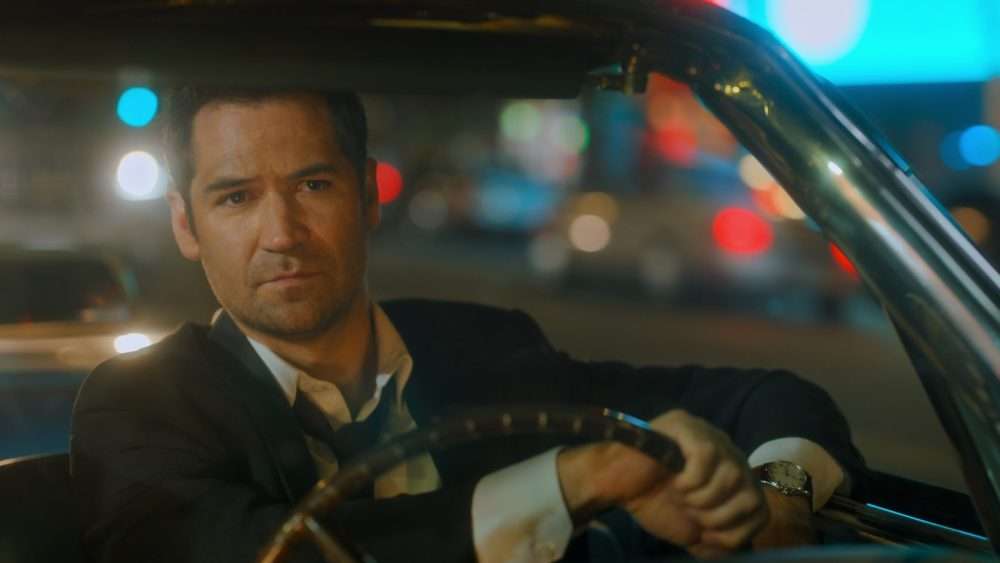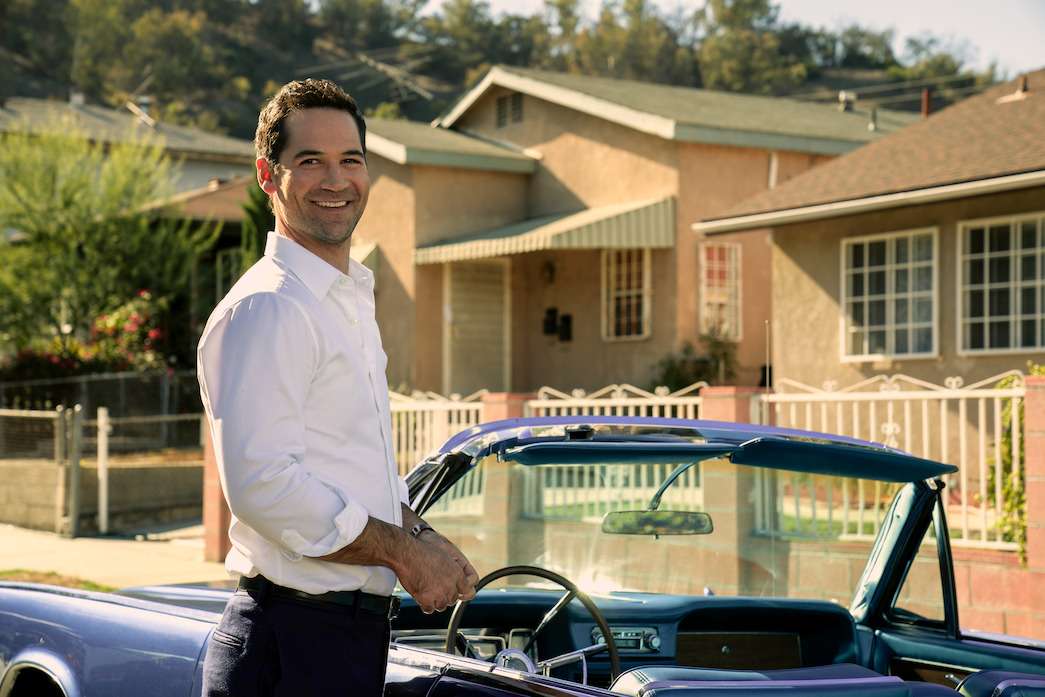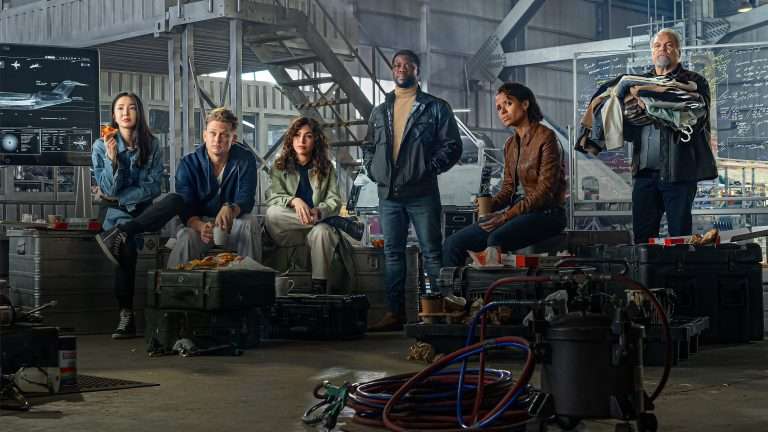The Lincoln Lawyer (Season 2, Part 2): The thing about procedures and the big issue with The Lincoln Lawyer are characters. Along with the protagonist, the supporting cast plays an important role. The world-building comes much later in the equation, primarily because of production purposes, as well as the target audience, setting a world closer to reality and showcasing a profession connected intrinsically to the real world helps ground the procedural, allowing the writers to then heighten the story for dramatic effects. But the characters are paramount; the actors need to be charismatic. Because those are the connective tissues with the audience, The Lincoln Lawyer suffers as a result because, other than Manuel Garcia Rulfo as Mickey Haller, Neve Campbell as his ex-wife Maggie McPherson (criminally wasted), and a delightful recurring appearance by Elliott Gould, each of the supporting cast members (both the core and the ancillary ones as a result of the plot) is bland. This is the key issue that is common through both of the seasons, and we haven’t even gotten into the issue specific to the current season; the storyline itself is just not very interesting.
The Lincoln Lawyer (Season 2, Part 2) Recap:
Episode 6: Withdrawal
Episode 6, titled Withdrawal, follows immediately from where Episode 5 left off, with a bruised and bloody Mickey Haller having lost consciousness after being beaten up by goons and left for dead at his parking garage near his Lincoln Navigator. While Haller flits in and out of consciousness, remembering his mother, we see Izzy finding him at the parking garage. Thankfully (because obviously), we see Mickey recovering slowly at the hospital, being met by Maggie and his daughter. Mickey then has a conversation with Izzy, where she reveals how she managed to find him because of the AirTags connected to all his Lincolns.
The missing contract providing Mickey power of attorney over Lisa’s affairs is prohibiting Henry from moving forward with his podcast and ensuring a limited series on Lisa and the case. Izzy surmises that the one time she left the keys to the Lincoln on her kitchen counter, her girlfriend Ray had the opportunity to grab the contract from the Lincoln. She and Izzy intended to build a dancing studio together, but Ray had been unable to secure her share of the funding. But surprisingly, she manages to pay her share the next day, which is highly suspicious. Mickey figures that Ray had been hired by Henry Dahl, the creator of the true-crime podcast, to steal the contract. To prove that theory, Mickey asks Izzy to hold onto that money. Once Mickey recovers, he takes the money in a zip-lock bag and immediately accuses Henry, threatening to pull Henry’s fingerprints from the cash and incriminate him. Deterred by that threat, Henry confesses to paying Ray off but also admits that he did not expect Mickey to be hurt and admitted to the hospital. According to Mickey, David Webber, and Alex Grant are using Dahl’s access to Lisa to ensure that she is framed for murder.
Mickey hatches a plan to lure Alex Grant, who is the contractor to whom Mitchell Bondurant had been blackmailing and who also owns Henry Dahl’s podcast (via David Webber, the chief sponsor of the podcast), out of hiding because of his connection to the Kazarian crime family. To that end, Cisco hires an ex-con to launch a fake website advertising a Tinto painting. The rarity of that painting should be enough to lure Alex out, which it does. Lorna and Izzy, posing as art gallery staff, greet Alex when he arrives to buy the painting. He is led by the two women to an easel holding a canvas covered in cloth. Alex is shocked to discover a subpoena instead, summoning him to open court.
To counter the inevitable hearing against the subpoena, Mickey instructs Lorna to make the hearing a media circus, and then at the hearing, during cross-examination, Mickey questions Alex about a well-known bid Alex’s construction business submitted to develop the Olympic Village community. Mickey inquires about the email Bondurant sent him threatening to disclose any suspicious conduct relating to their business relationship after Alex affirms his company is competing for the Olympic contract. Mickey assumes rightly that Alex will not plead the Fifth Amendment due to a media circus and reluctantly agrees to testify in Lisa Trammel’s murder trial.
On the personal front, Mickey’s accident inadvertently brings him closer to Maggie, who chooses to stay with him until he is back on his feet. The night of the hearing, Mickey and Maggie share a night of passion, and the next morning, Maggie reveals to Mickey that she has accepted a position at the DA’s office in San Diego, and she has taken the job not only because it is a good opportunity but also because while they are good together, it never works out in the long run, and she needs to move on. Thus, she leaves Micky heartbroken.
Episodes 7–10: The Trial
Mickey arrives home that night to find a mysterious letter on his doorstep. He discusses its contents the following morning over breakfast with Legal Siegal. It turns out that the document is a copy of an FBI target letter that informs Alex Grant that he is a supposed person of interest in a federal investigation. Legal Siegal asserts that the letter is either genuine and sent to assist in Lisa’s defense or a fabrication made for manipulation. Mickey has to ascertain that reality by cross-examining the chief investigative officer, Detective O’Brien, on the first day of the trial.
Mickey sends Cisco to ascertain whether the document is real by trying to bribe his FBI contact with backstage passes and inadvertently catching the attention of Special Agent Vasquez, who informs Cisco via denial that Alex Grant might be a chief person of interest. This comes at exactly the right time for Mickey, who was getting hammered at the trial by the prosecution. The prosecution had been grilling Detective O’Brien about the details of the case – a coffee cup from Cafe Maurice, a piece of glass from the side view mirror of a car, O’Brien’s belief that the killer had entered the garage on foot because of the poor quality of the security footage, and finally Lisa lying about having seen Bondurant on the day of the murder.
Finally, Mickey, having taxed the patience of the judge, brings up the letter on trial. This automatically forces the prosecutor to call for a sidebar, question the validity of the evidence, and ask to verify it herself. To her dismay, the document is verified, and Mickey is allowed to cross-examine O’Brien. He brings up that the letter was dated January 18, while Bondurant sent the blackmail letter on January 10. The relative closeness between those two dates is hard to ignore, and thus Mickey asks O’Brien whether they had adequately considered the possibility of investigating further instead of taking Lisa Trammel as the easy choice. O’Brien’s answer is enough to introduce reasonable doubt among the jury, notching a win for the day for the defense.
The next day, when Vasquez is called to testify, he mistakenly answers the prosecution’s question of whether Alex Grant is involved in an investigation as technically not. Upon cross-examining, Mickey understandably presses on the “technically” aspect, to which Vasquez reveals that he cannot elaborate on any question that might risk revealing details of an ongoing investigation. This again introduces reasonable doubt within the jury, which had been the FBI’s plan, and the subsequent conversation between Vasquez and Mickey reveals that the FBI might have sent the letter themselves, such that Haller can act as a wrecking ball and do their job of bringing Grant to justice.
However, the next day, Mickey is invited to the judge’s office, where the prosecutor reveals that they have finally recovered their “smoking gun” the suspected murder weapon being the missing hammer from Lisa Trammel’s toolkit, found caked with blood. As the trial continues, Mr. Beltran, a gardener for the neighborhood, testifies that he discovered that hammer in the hedges of the neighbor’s front yard. When Mickey questions him in cross-examination, he remarks that it is strange that six months after Bondurant’s murder, the murder weapon is suddenly discovered, and that too on a lawn that Beltran works to maintain day in and day out. Mickey also makes some interesting moves within the courtroom, which raises some eyebrows. He concedes the ownership of the murder weapon, stopping the prosecution’s cross-examination of O’Brien, and also concedes the blood splatter being Lisa Trammel’s own when the prosecution chooses to call on their next witness from the forensic department.
On the winning side, Mickey manages to grill Walter Kim about how his photograph of Lisa Trammell yelling at Mitchell Bondurant is being misrepresented. To prove his theory, he introduces video footage from the camera affixed to a cyclist’s helmet, which proves that Bondurant threatened to enter Trammel’s personal space, which forced her to slap him away. Couple that with Walter deleting all the other photos of that day, and this again produces reasonable doubt for the audience.
Back on the home front, Mickey is blindsided by two events. One is a surprise birthday being held by his daughter, and his mother is making a surprise appearance at his birthday party. Secondly, Lisa’s ex-husband comes to meet him and, when questioned by Mickey, reveals that he will testify in any matter dependent on Mickey’s choice, which makes Mickey extremely angry. He realizes that Jeff has returned to get a cut of the money from the podcast now that the case has gained traction.
Before the prosecution rests, Andrea (the prosecution) blindsides Mickey by bringing in Henry Dahl and utilizing audio from one of the unreleased episodes of his podcast to paint Lisa as a woman aggressively stalking and generally against Mitchell Bondurant. Finally, choosing to ensure that Dahl’s testimony is not the last thing the jury remembers before the weekend, Mickey chooses to finally bring Lisa to the stand. It works by adding a personal touch to the proceedings, as Lisa effectively shows her perspective and how Mitchell tried to make her life difficult throughout such that she and the rest of the community would be forced to vacate.
However, the prosecution chooses to cross-examine Lisa by picking apart her relationship with her ex-husband. That relentless questioning causes Lisa to snap, inadvertently proving the prosecution’s point of a hair-trigger temper on Lisa’s part, which might lend credence to the theory of Lisa Trammell being the murderer. Mickey, to fight back, brings out Dr. Arslanian, an independent forensics analyst, to voice a second opinion on the crime. She chooses to show how Lisa Trammell could not have physically assaulted Mitchell Bondurant by bringing out a 6-foot dummy named Manny and exhibiting through Lorna as the model how it is impossible for a 5-foot-6-inch tall woman with heels to hit a man square on the top of the head, and the injuries at his knee show that the man had fallen from standing straight up. The prosecutor, in response, bends the head of the dummy up and shows the hammer reaching the base of the skull, making it easier to hit. She then chooses to ask whether someone could have distracted Bondurant to look up (perhaps a spider), which would have given the murderer ease of access to commit the crime. While the demonstration was ludicrous, Mickey is now on the back foot because reasonable doubt has been introduced against Lisa Trammell.
Mickey finally brings Alex Grant to the stand. After recounting his familial history, his father being arrested for his crimes and effectively running a crime family from behind bars, and how Grant had chosen to change his last name to distance himself as well as gain legitimacy, Mickey was already successful in painting a negative picture passively. Then he comes in for the kill. He reveals through photographic evidence that Alex is in frequent contact with his uncle, who owns a bakery that acts as a legitimate front. His uncle and Alex are also co-owners of a moving company, whose van had been suspiciously captured in front of Bondurant’s office around the time of Bondurant’s murder. This grilling finally forces Alex to plead the Fifth Amendment, proving that even though his testimony would be struck off the record, the prosecutor would not be able to cross-examine him. His reticence in not answering and not defending the charges levied against him already put Alex Grant in a suspicious light before the jury.
The Lincoln Lawyer (Season 2, Part 2) Ending Explained:
Who killed Mitchell Bondurant?
The show reveals that Lisa’s employee Rene had managed to identify photojournalist Walter Kim as the health inspector who had been frequenting Bondurant’s establishment. Haller and Cisco realize that all signs point to Kim being the murderer and that Kim had been bribed by Alex Grant, and thus Bondurant had been indirectly threatening Kim as well as Alex Grant. It is not clear whether Kim acted on his own or had been under direct orders from Grant, but Kim’s involvement had been proved by the shard of glass (which had been used to distract Bondurant from looking up at the ceiling to check the flash of light and the blow from the hammer being delivered) being identified as belonging to one of Kim’s inspector tools. The revelation comes too late, as Walter Kim had disappeared, possibly being killed by Alex Grant to tie up all loose ends.
Was Lisa Trammell guilty?
This is a loaded question. On the one hand, the number of reasonable doubts planted by the jury was enough to sway the jury towards pronouncing Trammell not guilty of the murder of Mitchell Bondurant. The closing statement by Mickey Haller and his passionate defense of Lisa Trammell also helped. However, after Lisa finally fired Haller as her attorney and they finally shared a night of passion, Haller still could not shake the nagging feeling that he was missing something. The gears of his brain finally unlock at the end of the summer while he is out with his daughter. He goes to confront Lisa and forces her to effectively confess that Jeff Trammell is dead. The person who had pretended to be Jeff Trammell and had come to meet Mickey at the office had been an out-of-work actor and ex-employee of Lisa’s restaurant, hired by her to throw Mickey off the idea of bringing in Jeff Trammell as a suspect. While Lisa tries to make Mickey understand the abuse she had experienced in her relationship, Mickey finally realizes that Lisa had hidden the dead body in the plant bed where she had been growing the cilantro, a twisted act of poetic justice considering Jeff did not like cilantro. It is also why Lisa has been vehemently opposed to selling off this place. Unbeknownst to Mickey, Lorna, who had accompanied and been waiting in Mickey’s Lincoln while Mickey went to confront Lisa, had called the police to investigate a dead body that might be hidden at Lisa Trammel’s house. It’s an interesting, if bittersweet, ending. But it’s better not to be too melancholic because, according to Lorna (and this is pure conjecture but quite definitive), Lisa had been the one to hire goons to beat up Mickey at the parking garage, not Grant. That is pretty psychotic, and Mickey might have dodged a bullet.
The marriage of Cisco and Lorna
Cisco and Lorna finally get married in front of a courthouse after having been unable to secure the venue for their marriage. It almost felt like the universe (read: the writers) was trying to punish Lorna for helping Izzy secure the rent agreement for her studio after her broker tried to extort money from her by changing the agreement; the argument kind of works because it again feels like a similar situation in that regard. It also feels out of character for Lorna because she did not think to ask or follow up on paperwork. Regardless, we see Cisco holding an after-marriage party at Izzy’s new apartment cum dance studio, which also serves as the new soft opening. It does tease Izzy being written off the show because she is moving on from being the designated driver of the Lincoln Navigator, but the show also teases that Izzy would be around to take up the slack at Mickey’s office as Lorna goes off on her honeymoon.
What is the next case?
As this season of The Lincoln Lawyer ambles to a close, we see a black Audi almost trying to run over Mickey while he had been walking to his convertible after having dinner with Legal Siegel. Confirming with Izzy, Mickey realizes that Grant will be a recurring thorn in his side because of how Mickey pushed him into a corner in the case. Izzy also informs him that a man named Julian LaCosse, currently in the county jail, had requested him as a lawyer under the advice of his friend Giselle Dallinger. Unfortunately, LaCosse is believed to be guilty of murdering Dallinger. Mickey is confused because he is unable to recall a client of his with that surname until he goes to the county mortuary to identify the body and realizes that Giselle Dallinger is Gloria Dayton, AKA Glory Days, the prostitute who he had helped at the start of this season and who Haller would have to solve the murder of in a potential Season 3.
The Lincoln Lawyer (Season 2, Part 2) Final Thoughts:
Unlike Bosch, following a character again crafted from the same imaginative mind of Michael Connelly, The Lincoln Lawyer doesn’t have that balance of gritty realism and stylized sensibility that former knew how to execute. The Lincoln Lawyer suffers from showing the glitz and glamour of Los Angeles and crafting a TV show that hearkens back to the invincibility and jocularity of procedurals of old. As a result, even if the story is interesting, there isn’t any sense of stakes because the heroic music and the general easygoing relationship between the characters underscore their invincibility. No matter how complicated or tough the case is, Mickey Haller and his team will crack it. This is, again, not a bad approach, but considering the creators involved, you expect a bit more depth to the entire proceedings.
But even if the central plot isn’t as interesting as the previous seasons, the overall personal subplots of the characters aren’t as compelling as the writers would like the viewers to believe. Cisco and Lorna’s tribulations aren’t remotely compelling enough to warrant the story’s attention being shifted from the main plot or Mickey Haller’s personal life. Conversely, the actors aren’t adding much extra dimension to the characters already written on the page. As a result, “The Lincoln Lawyer” feels old-school, but while old-school procedurals are seeing a resurgence, there is a tendency by the writers to update these stories slightly, either by raising stakes, grounding them, or creating compelling characters to follow. The Lincoln Lawyer, on the other hand, is an old-school, mediocre procedural throwback in more ways than one. And honestly, that is what the audience desires, but even comfort food gets stale after a point.







![Evergreen [2019] Review: A Poignant Depiction of Love and Relationship](https://79468c92.delivery.rocketcdn.me/wp-content/uploads/2019/05/MV5BYjJhZDQ3MGMtOTYzNS00YTkwLWE0ZWUtNGNmMTk2ODc0YWQ1XkEyXkFqcGdeQXVyNTA4MjU3NTU@._V1_QL50_SX1777_CR001777960_AL_-768x415.jpg)


![David Attenborough: A Life on Our Planet [2020] Netflix Review – A Clarion Call to Save the World](https://79468c92.delivery.rocketcdn.me/wp-content/uploads/2020/10/David-Attenborough-A-Life-on-Our-Planet-Netflix-1-highonfilms-768x384.jpg)
